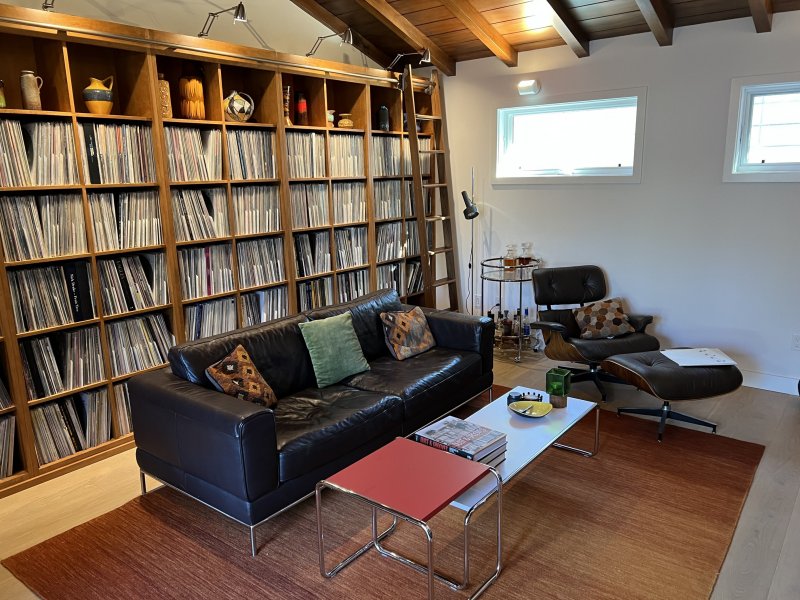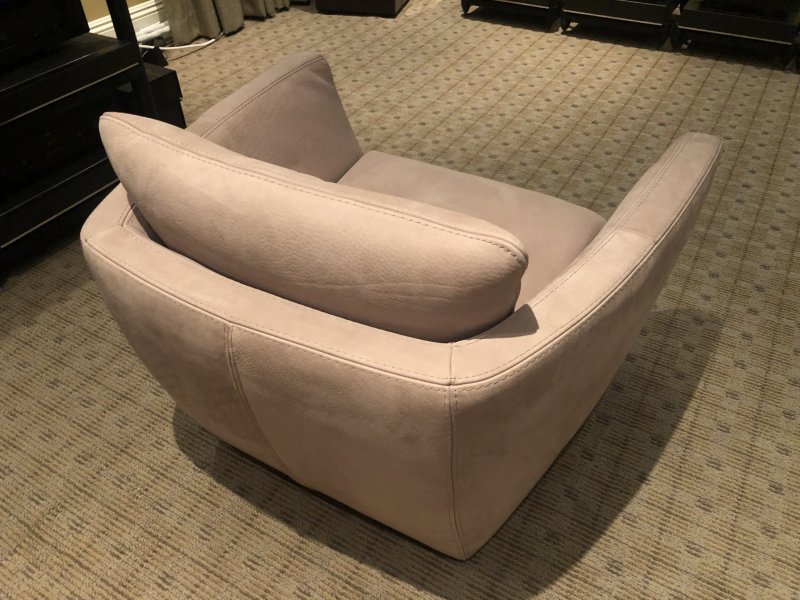Custom dedicated audio room owners unite!
- Thread starter sbo6
- Start date
You are using an out of date browser. It may not display this or other websites correctly.
You should upgrade or use an alternative browser.
You should upgrade or use an alternative browser.
Wow ! Cool looking room !If you have not tried Gulf of Maine fabric, take a look at them. They have a good stretch to them and the right fabric can go on in any direction and looks perfect. All of my walls are done with 2" thick Owens Corning 705 fiberglass in a 3 " deep frame stretched with Gulf of Maine Fabric.
When I built my room I chose total dampening and then added diffusion as needed to create the spaciousness I wanted.
My approach is not for everyone but I am very happy with the results.
View attachment 104761
Panel and Acoustic Fabrics | Duvaltex
Discover our Panel and Acoustic Fabrics. More than 100 colors, patterns and textures available | Duvaltex
Excellent products. Shipping a little pricey due to tube packing aspect for width dimension.
Wow Brad! Who makes those Mad Max pointy diffusors? I have not noticed them before. Cheers...When I built my room I chose total dampening and then added diffusion as needed to create the spaciousness I wanted.
One of my wife's tennis friends that was at out home for a girls wine fest saw them when my wife was giving a tour of our home. She walked in and said " is this some kind of 50 shades of gray thing". It drew quite a laugh.Wow Brad! Who makes those Mad Max pointy diffusors? I have not noticed them before. Cheers...
They are a DIY diffusion panel that my EE friend that is just finishing rebuilding my 610t amps pushed me to try. He had mentioned his diffusion panels but I didn't believe they would really work as he suggested.
He brought over 4 of them without me knowing they were coming and he asked me to just give them a try. I was stunned with their functionality.
They are nothing more than plastic martini glasses without the bottoms. Using Gorilla gel supper glue they are laid out on 1/4" foam core board. Once glued in place I painted them with Krylon spray can of black and green.
The way mine are hung I can move them anywhere along the absorption panels to achieve the sound I am looking for.
I'm
Mostly acoustics is about lowering transmission between rooms and its done via these lossy wall systems so there is not a lot of info on fr response
Of course you can go all out with multiple layers and close stud centres to keep more bass in the room
I have a concrete mapnary room and a friend has 2 layers of 15mm fire rated sheetrock over close studs and there definitly is a bass dip in the latter
Phil
That is an interesting topic .. if you use mass and rigidity to sound proof the room ( both in and out) you keep most of the bass in the room... if you use layers of sheetrock, membrane damping, resilient mounts etc .... you are absorbing sound energy and that is difficult to predict what amount unless its a very controlled and tested system. A good reason to get some expert advice. It has the advantage of bass absorbtion and sounproofing with one systemDo people generally use layers of drywall and vinyl membrane to deaden the room itself or to keep sound from reaching other parts of the house?
Mostly acoustics is about lowering transmission between rooms and its done via these lossy wall systems so there is not a lot of info on fr response
Of course you can go all out with multiple layers and close stud centres to keep more bass in the room
I have a concrete mapnary room and a friend has 2 layers of 15mm fire rated sheetrock over close studs and there definitly is a bass dip in the latter
Phil
Anchorage was the line I used in my room. They have some new textures that would not be as easy to stretch on a frame, due to the pattern.Panel and Acoustic Fabrics | Duvaltex
Discover our Panel and Acoustic Fabrics. More than 100 colors, patterns and textures available | Duvaltexshop.guilfordofmaine.com
Excellent products. Shipping a little pricey due to tube packing aspect for width dimension.
What brand and model are the chairs? I especially like the narrow back of the main listening chair.
gshelley,
The chair is a Vanguard Woodley Recliner. I altered the back to only be a head rest at the top and built the footstool.
If you go to the Members Systems. My room is on the 3rd page called "My Happy Place". There is a description and pictures of the chair before and during the alterations.
As for the 2 barrel chairs. We purchased them for our family room in Florida when we moved here in 1985. I have no idea the brand. They were from a no name furniture store. I'm amazed they have lived this long.
The chair is a Vanguard Woodley Recliner. I altered the back to only be a head rest at the top and built the footstool.
If you go to the Members Systems. My room is on the 3rd page called "My Happy Place". There is a description and pictures of the chair before and during the alterations.
As for the 2 barrel chairs. We purchased them for our family room in Florida when we moved here in 1985. I have no idea the brand. They were from a no name furniture store. I'm amazed they have lived this long.
For my dedicated room the two most important things were isolated power and non-audiophile acoustic elements. Using a ceiling with non-even wood rafters (purely decorative) helped tame any reflections. The rear wall (most important element in an audio room IMO) is where my record collection sits. This acts as a giant diffuser and eliminates the dreaded clap eco.
My room is more of a dedicated "music living room" than a dedicated audio room.

My room is more of a dedicated "music living room" than a dedicated audio room.

Steve Williams
Site Founder, Site Co-Owner, Administrator
I prefer my back be straight upon and not having my ears recline. I looked for years for my perfect chair. I recommend a chair where the back of the chair stops well below the shoulders
Steve Williams
Site Founder, Site Co-Owner, Administrator
Steve Williams
Site Founder, Site Co-Owner, Administrator
Steve Williams
Site Founder, Site Co-Owner, Administrator
Steve Williams
Site Founder, Site Co-Owner, Administrator
I believe the back of the chair should not rise above the shoulders
I agree Steve. The back on my chair is 2" below my shoulders.I believe the back of the chair should not rise above the shoulders
The head rest is mandatory for me. I get so engaged to the music I often drift off and my head would fall backwards.
...I have a three position recliner.
1) Normal/upright chair. Suitable for scrunched-forward and/or hunched-over audiophile-intense listening. The least fun option.
2) Foot-rest kicks up, and back tilts a wee bit. Invaluable for whiskey-augmented listening. Most fun option.
3) Full-kip position. Almost horizontal. Best utilized when no interruptions are forecasted from Sweetie or the dog. Often engaged shortly after "augmented" listening segment (see #2 above). While not perfectly optimized for SQ, sound is still excellent, and the resultant restive delirium more than makes up for the slight reduction in high-frequency reception. Most transcendental option. Highly recommended!
1) Normal/upright chair. Suitable for scrunched-forward and/or hunched-over audiophile-intense listening. The least fun option.
2) Foot-rest kicks up, and back tilts a wee bit. Invaluable for whiskey-augmented listening. Most fun option.
3) Full-kip position. Almost horizontal. Best utilized when no interruptions are forecasted from Sweetie or the dog. Often engaged shortly after "augmented" listening segment (see #2 above). While not perfectly optimized for SQ, sound is still excellent, and the resultant restive delirium more than makes up for the slight reduction in high-frequency reception. Most transcendental option. Highly recommended!
Excellent choice of Eames replica ? … we have a pair coming hopefully during MarchMy room is more of a dedicated "music living room" than a dedicated audio room.
View attachment 104964
Similar threads
- Replies
- 77
- Views
- 9K
- Replies
- 38
- Views
- 9K
- Replies
- 2
- Views
- 2K
- Replies
- 4
- Views
- 2K
- Replies
- 4
- Views
- 3K
| Steve Williams Site Founder | Site Owner | Administrator | Ron Resnick Site Owner | Administrator | Julian (The Fixer) Website Build | Marketing Managersing |










